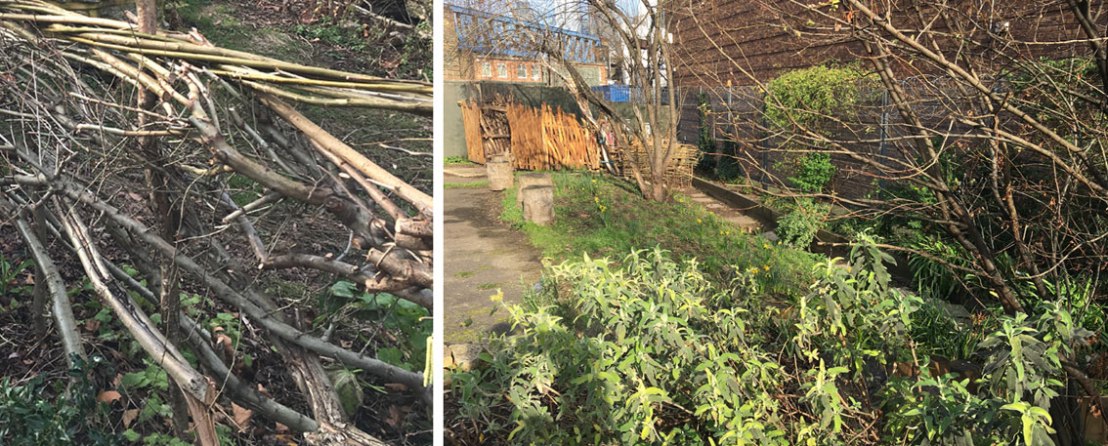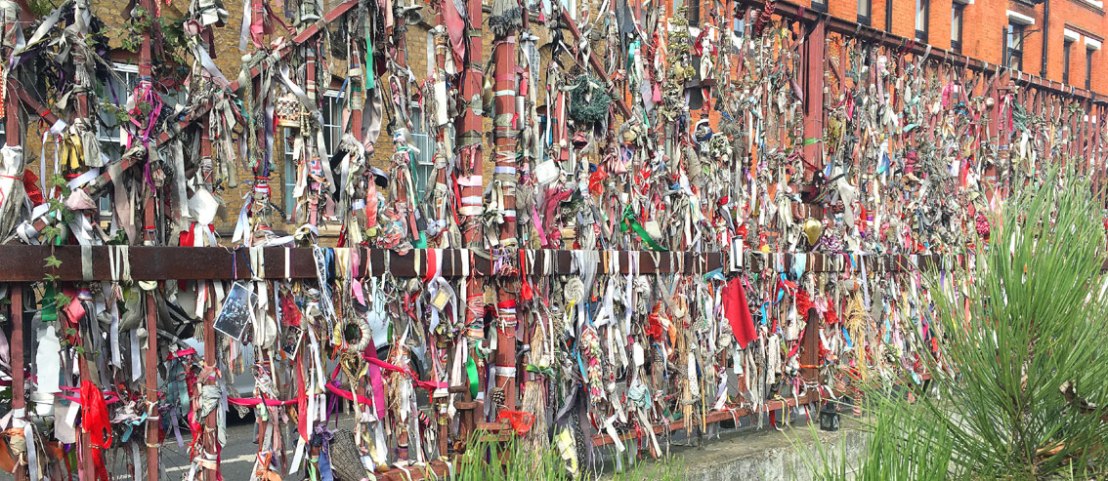 ‘Sage, skulls and oyster shells’ (Wednesday 13 February 2019)
‘Sage, skulls and oyster shells’ (Wednesday 13 February 2019)
The entrance gates are chained when I arrive at 11. A flapping laminated sign tells me I have an hour to kill before the garden opens. So I wander the maze of surrounding Southwark streets between tall warehouse buildings, transformed from Victorian industrial grime into trendy loft apartments and designer office space. I pick up a coffee and get back well before 12 to find the gates already opened. Welcomed by smiley volunteers, I follow the entrance walkway, sloping up under its wonderful goose wing wooden roof, supported on twisty hand wrought posts (designed and built by Arthur de Mowbray).
Once dank and misty marshland rolling down to the southern tide torn banks of the Thames, Southwark has been linked by bridge to the City since Roman times and has since seemed an integral part of London. In the 12th century an Augustinian priory was founded close to the river, about half a mile north east of here, where Southwark Cathedral now stands. This was under the patronage of the Bishops of Winchester, who governed this district from their London seat of Winchester Palace. This area became known as the ‘Liberty of the Clink’, after the notorious ‘Clink’ prison, run by the Bishops of Winchester until 1780, when it was burnt down by Gordon rioters.
The Liberty of the Clink, being outside the jurisdiction of the City of London, became a place of entertainment with theatres, bear baiting, bull pits, taverns and brothels under licence from the Bishop, leading to the local prostitutes being nicknamed ‘Winchester Geese’.
The burial ground here is thought to have been established originally as an unconsecrated graveyard for these prostitutes and was known as the ‘Single Women’s Burying Ground’, but by 1769 it had become a pauper’s cemetery (regularly preyed on by body-snatchers who provided cadavers for anatomy classes at nearby Guy’s Hospital).
The garden has a homely backyard character that seems to have evolved through unfettered creativity of many unknown hands: making, planting, building, painting, sculpting, writing. Rough stone walls, grafitied poetry, corner shrines made from broken pots and stone masks and stretches of hedging lovingly laid. Much evidence underfoot of the recent history of this space in its cracked patchwork of concrete floors, mossy tarmac, rough blockwork, rickety wooden hoardings, stain streaked brick walls. And throughout the garden reference to its more distant history in the presence of decorated and spangled skulls, planted in beds and hidden corners as reminders of those buried here, names long forgotten. A rough pyramid, 2 metres high or so, dominates the north end of the garden, built up from fragments of stone and mortar reclaimed from this ground, adorned on one side with oyster shells (a reminder of the staple diet of the poor in this area who, living close to river, relied on this abundant and cheap protein source for most of their lives).
In the 19th century two charity schools, for boys and girls, were built on the south end of the graveyard, restricting the space for burials. By the 1850s the ground had become so overcrowded and conditions so squalid that it was closed. The site was sold for building in 1883, but this was declared void under the Disused Burial Grounds Act of 1884 so it remained vacant, despite threats of development over the years (although it did have temporary uses during the 20th century as a timber-yard, warehousing and once even a fairground!). An archaeological dig by the Museum of London in the 1990s, prior to the construction of an electricity substation for the Jubilee line extension, uncovered 148 of the Victorian graves. Over a third of the bodies were babies and most of the adults were women aged 36 and over. It is estimated that nearly 15,000 people had been buried here over the centuries.
The midday dong dong dong.. from the church across the street. A reminder that my drawing time is limited. So I set up in front of a herb bed, tangled with rosemary and sage, last season’s dried flowers, tawny heads nodding, and look across to the red iron memorial gates- the ragged shrine to the outcast dead, of bright colourful ribbons and notes and messages and photos and mementos and dried flowers and strings of beads. This shrine to the ‘Outcast Dead’ was created by the Friends of Crossbones (established to protect this ancient burial ground by Southwark writer and poet, John Constable, following a vision he had in 1996 in which The Goose appeared as the spirit of Crossbones protecting her outcast children). Regular events happen in and around the site including talks, workshops and Halloween processions. A candlelit vigil is held on the 23rd of each month instigated by the Friends of Crossbones, when visitors can bring their own ribbons, mementos or totemic objects to tie to the memorial gate.
Above the walls and hoardings, the austere faces of Victorian terracing on Redcross Way stare down sternly. The crisscross steelwork of railway bridges, and the endless trundle and squeech of southeastern trains from London Bridge station. And beyond, the jutting cranes of riverside development lead my eye over to the angled cluster of city skyscape.
A volunteer with biker jacket and punk hair (I later discover her name is Nik) is diligently lighting candles in lanterns and placing them on walls under the shrine to the outcast dead and around the garden. Reverential and with a sacred step. Priest like.
Between 2006 and 2012 a secret guerrilla wildflower garden was created on the site, tended by ‘invisible gardener‘ Andy Hulme, who was living in a caravan on the site (he was later to work as gardener for Vivienne Westwood). He created figure of eight ‘infinity beds’ and the Pyramid from old bricks, lime mortar and rubble. In 2015 a ‘meanwhile garden‘ lease was granted which has allowed Bankside Open Spaces Trust (BOST), supported by a team of volunteers, to create a new garden. Designed by Helen John, it incorporates elements of the ‘invisible garden’ as well as new features such as the ‘Goose Wing’ entranceway, drystone walls and a wildflower meadow next to the Jubilee Line substation. Raised planting beds were used in order not to disturb human remains beneath the ground.
A scruffy pigeon lands on top of the gates, perching there to become, for a moment, part of the shrine, before flapping down to the sloping lawn where little early narcissi have pushed through the patchy winter turf.
Today’s chill breeze tucks around my neck but the sun shines warm and I feel comfortable here, at home in this shared space. I’m aware that soon the gates will be rattled shut and I have to hurriedly finish my drawing. I’d like to build a shrine here or add an offering to the ragged memorial. And I look across once more and catch a pale face staring through, framed with ribbons.
In his ‘Sticks in the Smoke’ project, Nick Andrew has been regularly visiting, researching and drawing different publicly accessible parks or gardens in London since January 2016, exploring the theme of city green spaces from the perspective of a rural landscape painter. The first two sketchbooks will be published as a book in late 2019. www.nickandrew.co.uk . Nick is grateful to London Parks & Gardens Trust for their support www.londongardenstrust.org.
Cross Bones Garden, Redcross Way, Southwark, London, SE1 1TA
Opening times: 12noon – 2pm (variable depending on volunteer stewards)
Google earth view




